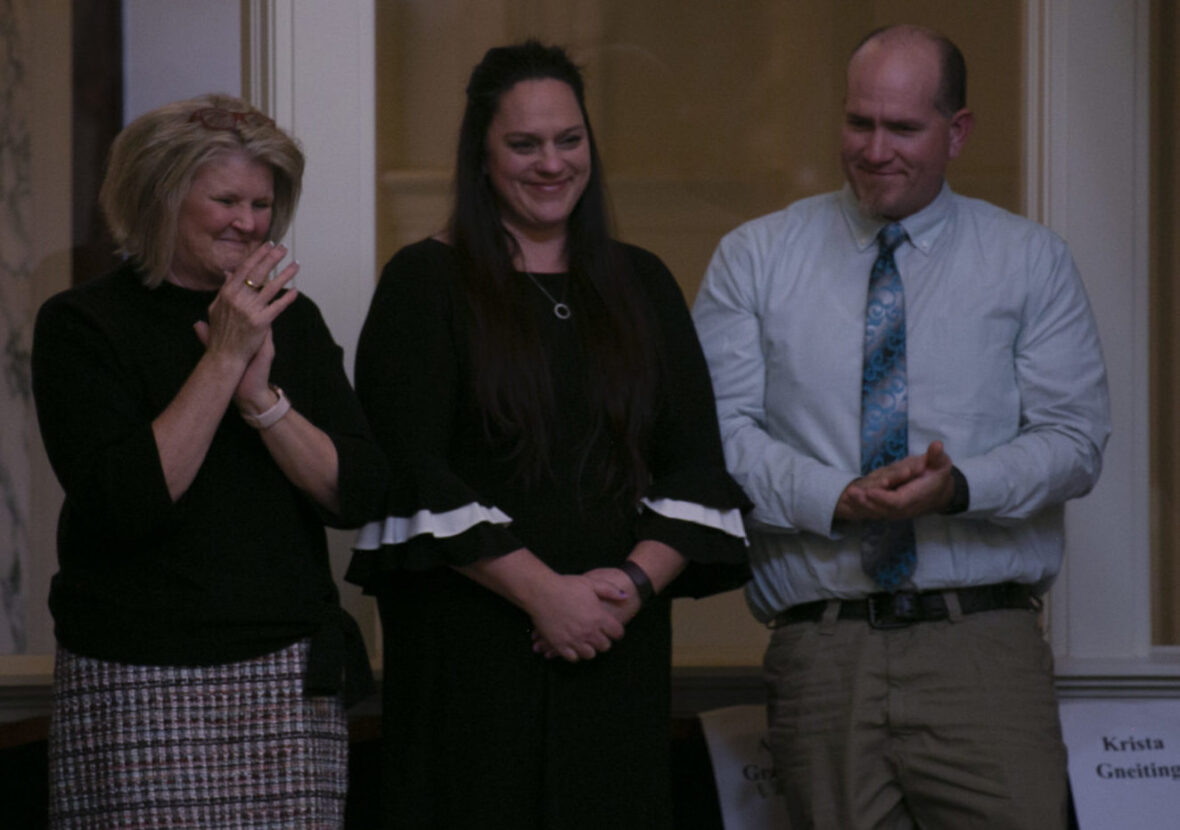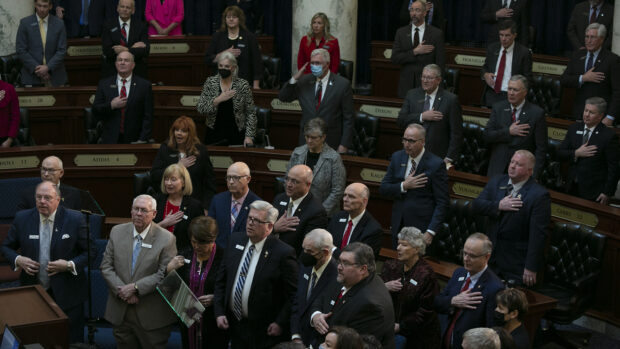Gov. Brad Little proposed bonuses and raises for teachers and a historic 11% increase to K-12 education funding on Monday as he kicked off the 2022 legislative session with his State of the State address.
He also called on the Legislature to bankroll a $50 million-grant program to help families, and offered flexible literacy dollars that school districts could use to fund all-day kindergarten.
“Our investments in education later on will have more impact if we can work with families to get more students to read proficiently early on,” Little told House and Senate members in his address on the Idaho Capitol’s House floor.
If the Legislature passes Little’s requested budget, Idaho schools would enjoy their largest state funding increase in Idaho history, in terms of dollars spent, Little’s budget chief Alex Adams told reporters Monday.
While requesting added funding, Little urged prudence with the state’s record surplus, which he pegged at $1.9 billion Monday. And he pushed tax cuts and rebates while railing against “Bidenflation” in a series of jabs at the Democratic White House.
The Governor emphasized education and infrastructure as his top priorities, echoing the focus on schools that he’s preached since his 2018 gubernatorial campaign.
An emotional moment came when Little recognized Rigby Middle School teacher Krista Gneiting, who disarmed a sixth-grade shooting suspect in May of last year. Gneiting stood in the House to a standing ovation.

Little’s budget proposal provides a roadmap for the Governor’s priorities heading into the new year. Over the coming months, lawmakers will decide whether to fund Little’s asks.
Education highlights from the budget
This year’s public schools budget topped $2 billion for the first time in state history. Little wants to put roughly $300 million of new money into K-12 next year, an 11% increase.
Little’s proposed K-12 budget increase includes several line items:
- A 10% boost in state dollars available for teacher pay raises. Little wants to accelerate the teacher career ladder and pay for two years of raises in one year. The price tag would be $104 million, covered from a combination of state general funds and federal coronavirus aid. In 2021, Little sought and received $44.9 million of new money for the career ladder.
- A $1,000 bonus for every teacher.
- A 5% pay raise for school classified staff.
- A $105 million line item designed to help cover schools’ health insurance premiums — and reduce out-of-pocket costs for staff. This translates to about $4,000 per teacher.
- An additional $47 million for literacy programs — which would give schools the flexibility to provide all-day kindergarten, or take other steps to help at-risk readers. This would come on top of the current $26 million-a-year literacy line item. One literacy item is gone, however: a one-time, federally funded $20 million summer literacy program from 2021.
- A $50 million “Empowering Parents Grants” program, designed to help cover family education expenses. The federally funded proposal would be modeled after the federally funded Strong Families, Strong Students grant program, launched in the fall of 2020.
- In higher education, Little is calling for a 7.1% budget increase for the state’s four-year institutions and a 4.8% increase for community colleges.
Little is also recommending the Legislature add $44 million to the rainy-day fund for public schools this fiscal year and $77 million in the 2023 fiscal year. He’s also requesting that the Legislature unfreeze the Public Education Stabilization Fund, which it froze last year.
With the state sitting on a potential $1.9 billion budget surplus, tax cuts also figure prominently in Little’s election-year agenda.
He has proposed more than $350 million in immediate income tax rebates, about a 12% rebate overall.
Little also wants to reduce Idaho’s highest individual income tax rate from 6.5% to 6%, and an identical cut in corporate tax rates. These cuts would cost about $250 million per year.
Monday’s State of the State address was a return to normal, of sorts. After delivering the address remotely last year, Little addressed members of both chambers of the Legislature and fellow statewide elected officials on the Idaho Capitol’s House floor.
Officials offer mixed reactions
One of those officials, Lt. Gov. Janice McGeachin, launched a series of tweets criticizing Little as he gave his address. Around 20 minutes into the address, she knocked Little for his call to increase the education budget.
Idaho's children have suffered a significant loss of learning over the last two years, and Brad wants to throw more money at government schools. Let's start funding kids and families rather than the schools. It's time for the money to follow the students! #idpol #idleg
— Janice McGeachin (@JaniceMcGeachin) January 10, 2022
McGeachin is running for governor, and will challenge Little in the Republican primary in May if he announces a reelection run, as he’s expected to.
Little’s proposals received a warmer reception from state superintendent Sherri Ybarra, who said she’s “very supportive of the direction we’re going.”
“It’s a great day for education,” she told EdNews after the address.
Ybarra further hailed the governor’s planned K-12 investment in a statement Monday afternoon, calling it “a glimpse of a bright future in the midst of the setbacks and disruptions of this long-running pandemic.”
Idaho Education Association President Layne McInelly was similarly pleased with Little’s proposal, saying the Governor’s “commitment to improve Idaho public education shines through in the recommendations he made to the Idaho Legislature today.” He pointed to boosts in funding for teachers’ health insurance, along with their salaries as “strong steps forward” in a prepared statement.
Democrats applauded the increases to education funding, but called for more.

“We are nowhere near out of the woods in terms of addressing the core vital services that government is responsible for providing in the state,” House Minority Leader Ilana Rubel told reporters Monday afternoon.
“Until we are out of last place in education, this is no time for a victory lap,” the Boise representative said, referring to the Idaho’s U.S.-low rank in per-pupil spending.
Republican legislative leaders struck a different tone at their own press event, generally expressing support for Little’s proposals.
“I need some more detail on a few items, but I did not leave that speech with a list of things that I did not like,” House Speaker Scott Bedke, R-Oakley, said.
Bedke’s fellow House Republicans — who cut into university budgets last year over concerns about leftist indoctrination — may be tougher to predict if line items like Little’s desired 7.1% budget boost for higher education come to a vote.
“I’m not going to try to commit the caucus or predict the caucus,” Bedke said of another of Little’s requests.
Click here to watch Little’s full address or here to read it.
Idaho Education News reporter Devin Bodkin contributed to this developing story.
